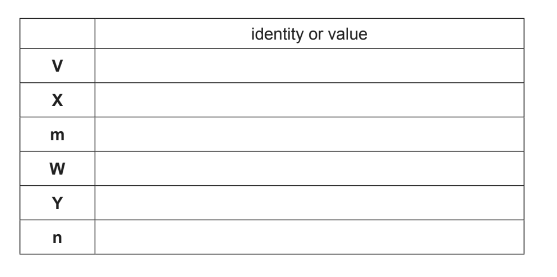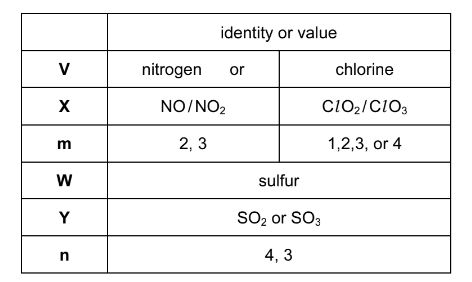Question
Two elements, V and W, are in adjacent groups in the Periodic Table.
V reacts with oxygen to form an acidic gas, X. V forms an anion with formula VOm–.
W reacts with oxygen to form an acidic gas, Y. W forms an anion with formula WOn2–.
A solution of WOn2– forms a white precipitate with Ba2+(aq) but shows no visible reaction with Mg2+(aq).
(a) Complete the table below.

(b) By referring to enthalpy changes, explain why WOn2– forms a white precipitate with Ba2+(aq) but shows no visible reaction with Mg2+.
Answer/Explanation
Answer: (a)

(b) M1: (white precipitate is BaSO4) descending the group ∆Hsol becomes more endothermic / positive;
M2, M3 any two from:
∆Hlatt decreases /becomes more endothermic / becomes less exothermic
∆Hhyd decreases / becomes more endothermic / becomes less exothermic
∆Hhyd decreases more than ∆Hlatt
Question
(a) Explain what is meant by the term ionisation energy.
(b) The first seven ionisation energies of an element, A, in \( kJmol^{–1},\) are
1012 1903 2912 4957 6274 21269 25 398.
(i) State the group of the Periodic Table to which A is most likely to belong. Explain your answer.
(ii) Complete the electronic configuration of the element in Period 2 that is in the same group as A.\( 1s^{2}\)
(c) Another element, Z, in the same period of the Periodic Table as A, reacts with chlorine to form a compound with empirical formula \(ZCl _{2}\). The percentage composition by mass of \(ZCl_{ 2}\) is Z, 31.13; Cl, 68.87.
(i) Define the term relative atomic mass.
(ii) Calculate the relative atomic mass,\( A_{r} \), of Z.
Give your answer to three significant figures.
(d) The chlorides of elements in Period 3 of the Periodic Table show different behaviours on addition to water, depending on their structure and bonding.
(i) Write equations to show the behaviour of sodium chloride, NaCl, and silicon chloride,
\(SiCl_{ 4}\) , when separately added to an excess of water.NaCl
\(SiCl_{4 }\)
(ii) State and explain the differences in behaviour of these two chlorides when added to water, in terms of their structure and the bonding found in the compounds.
(e) Sulfur reacts with fl uorine to form\( SF_{6}\). State the shape and bond angle of \(SF_{6}.\)
shape of\( SF_{6}\)
bond angle of\( SF_{6}\)
▶️Answer/Explanation
(a) The amount of energy required/ energy change/ enthalpy change when one electron is
removed
from each atom/(cat)ion in one mol
of gaseous atoms /(cat)ions
OR energy change when 1 mole of electrons is removed from one mole of gaseous
atoms / ions
\(X(g) → X+(g)^{ +} e^{–}\) gains 2 marks
(b) (i) Group V/ 5/ 15
Big difference between fifth and sixth ionisation energies
(ii)\( 1s^{2} 2s^{2} 2p^{3}\)
ecf from (b)(i) if period 2
(c) (i) (Weighted) mean/ average mass of an atom(s) (of an element)
Relative to\( 1 / 12^{th}\) of (the mass of an atom of) carbon-12 OR
relative to carbon-12 which is (exactly) 12 (units)
allow as an expression
(ii) Z Cl
\(\frac{31.13}{A_{r}} \frac{68.87}{35.5}\)=1:2
so \(\frac{6887/35.5}{31.13/A}\)=2
$A_{r}=\frac{2\times 31.13\times 35.5}{68.87}=32.023=32.1$ to 3sf.